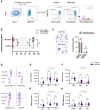Neutrophil Diversity (Immature, Aged, and Low-Density Neutrophils) and Functional Plasticity: Possible Impacts of Iron Overload in β-Thalassemia
- PMID: 39408979
- PMCID: PMC11476590
- DOI: 10.3390/ijms251910651
Neutrophil Diversity (Immature, Aged, and Low-Density Neutrophils) and Functional Plasticity: Possible Impacts of Iron Overload in β-Thalassemia
Abstract
Neutrophil dysfunction is a form of immune suppression in patients with β-thalassemia (Beta-thal), although data on this are limited. In this study, blood from patients and healthy volunteers was analyzed. Flow cytometry analysis demonstrated an increase in immature neutrophils (CD16- CD62L+) and aged (senescent) neutrophils (CD16+ CD62L-) in Beta-thal patients compared to healthy volunteers. The Beta-thal neutrophils demonstrated less prominent chemotaxis and phagocytosis than healthy neutrophils at the baseline. With phorbol myristate acetate (PMA) or lipopolysaccharide (LPS) stimulations, some of the indicators, including the flow cytometry markers (CD11b, CD62L, CD66b, CD63, apoptosis, and reactive oxygen species) and neutrophil extracellular traps (NETs; detected by anti-citrullinated histone 3 immunofluorescence), were lower than the control. Additionally, low-density neutrophils (LDNs), which are found in the peripheral blood mononuclear cell (PBMC) fraction, were observed in Beta-thal patients but not in the control group. The expression of CD11b, CD66b, CD63, arginase I, and ROS in LDNs was higher than the regular normal-density neutrophils (NDNs). The proliferation rate of CD3+ T cells isolated from the PBMC fraction of healthy volunteers was higher than that of the cells from patients with Beta-thal. The incubation of red blood cell (RBC) lysate plus ferric ions with healthy NDNs transformed the NDNs into the aged neutrophils (decreased CD62L) and LDNs. In conclusion, iron overload induces neutrophil diversity along with some dysfunctions.
Keywords: iron overload; low-density neutrophils; neutrophil diversity; thalassemia.
Conflict of interest statement
The authors declare no conflicts of interest.
Figures






Similar articles
-
Immune suppressive activities of low-density neutrophils in sepsis and potential use as a novel biomarker of sepsis-induced immune suppression.Sci Rep. 2025 Mar 19;15(1):9458. doi: 10.1038/s41598-025-92417-7. Sci Rep. 2025. PMID: 40108283 Free PMC article.
-
High Purity Isolation of Low Density Neutrophils Casts Doubt on Their Exceptionality in Health and Disease.Front Immunol. 2021 Jun 8;12:625922. doi: 10.3389/fimmu.2021.625922. eCollection 2021. Front Immunol. 2021. PMID: 34168640 Free PMC article.
-
[Phenotype and function of neutrophils in normal human peripheral blood].Xi Bao Yu Fen Zi Mian Yi Xue Za Zhi. 2024 Oct;40(10):865-871. Xi Bao Yu Fen Zi Mian Yi Xue Za Zhi. 2024. PMID: 39442984 Chinese.
-
Low-Density Neutrophils in Systemic Lupus Erythematosus.Arthritis Rheumatol. 2020 Oct;72(10):1587-1595. doi: 10.1002/art.41395. Epub 2020 Aug 26. Arthritis Rheumatol. 2020. PMID: 32524751 Free PMC article. Review.
-
Neutrophil Activated by the Famous and Potent PMA (Phorbol Myristate Acetate).Cells. 2022 Sep 16;11(18):2889. doi: 10.3390/cells11182889. Cells. 2022. PMID: 36139464 Free PMC article. Review.
Cited by
-
Immune suppressive activities of low-density neutrophils in sepsis and potential use as a novel biomarker of sepsis-induced immune suppression.Sci Rep. 2025 Mar 19;15(1):9458. doi: 10.1038/s41598-025-92417-7. Sci Rep. 2025. PMID: 40108283 Free PMC article.
-
Lacticaseibacillus rhamnosus attenuates uremic toxins in patients with nondialysis chronic kidney disease through the anti-inflammatory molecules.Sci Rep. 2025 Jul 31;15(1):27990. doi: 10.1038/s41598-025-12768-z. Sci Rep. 2025. PMID: 40744977 Free PMC article. Clinical Trial.
References
-
- Sae-Khow K., Charoensappakit A., Visitchanakun P., Saisorn W., Svasti S., Fucharoen S., Leelahavanichkul A. Pathogen-Associated Molecules from Gut Translocation Enhance Severity of Cecal Ligation and Puncture Sepsis in Iron-Overload β-Thalassemia Mice. J. Inflamm. Res. 2020;13:719–735. doi: 10.2147/JIR.S273329. - DOI - PMC - PubMed
MeSH terms
Substances
Grants and funding
- the 90th Anniversary of Chulalongkorn University/Chulalongkorn University
- N41A640076/the National Research Council of Thailand (NRCT)
- N34A660583/the National Research Council of Thailand (NRCT)
- B16F640175/the Program Management Unit for Human Resources, Institutional Development, Research, and Innovation
- HEA663000017/the Thailand Science research and Innovation Fund, Chulalongkorn University
LinkOut - more resources
Full Text Sources
Research Materials
Miscellaneous

